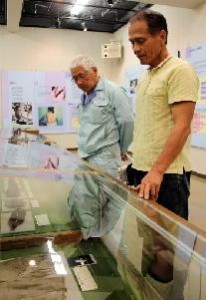Nuclear Reactors Rekindled, Part 1, Article 4
Jul. 1, 2012
Part 1: Through the eyes of A-bomb survivors
Article 4: Feelings about the construction of nuclear plants
by Aya Kano, Staff Writer
Mixed feelings over “nuclear power plant money”
“It’s true that our community has always had plenty of job opportunities. So it can’t be helped if others say we’ve been ‘rewarded,’” said Hiroaki Matsuura with a rueful smile. Mr. Matsuura, 63, runs a construction company in the city of Matsue in Shimane Prefecture. His company is located about eight kilometers south of the nuclear power plant operated by the Chugoku Electric Power Company.
Mr. Matsuura started the construction company in 1989, after returning to his hometown from Osaka. The nuclear plant’s No. 2 reactor was beginning commercial operations at this time. Mr. Matsuura became a subcontractor for the nuclear facility, engaging in such tasks as installing water pipes, lightning rods, and other devices for the No. 2 reactor, and constructing dormitories for the construction workers who built the No. 3 reactor. The work benefited his business, but, he added, “The big companies snatched up the bigger contracts. I don’t think I made out as well.”
Mr. Matsuura also serves as the chair of the association of second-generation A-bomb survivors living in the city of Matsue, a group comprised of about 80 people. During the war, his father was a member of the Akatsuki Shipping Transport Unit [the Imperial Japanese Army’s Shipping Command] and was exposed to the atomic bomb while in Higashisenda-machi, part of Naka Ward. His father died eleven years ago at the age of 75. “I wanted to carry on my father’s experience and struggle after the bombing,” Mr. Matsuura said. It has been five years since the association was founded.
The accident at the Fukushima No. 1 (Daiichi) nuclear power plant released an enormous amount of radioactive substances. Local residents of the surrounding towns were forced to leave their homes, farms, and fields behind, and are not permitted to even enter their communities. He imagines the scenario if a similar accident occurred at the Shimane nuclear plant, located in Matsue, the capital of Shimane Prefecture. The plant is the only one, among all of Japan’s prefectures, located in a capital city. “There’s no such thing as absolute safety when it comes to nuclear power plants,” he stressed.
Some associations of second-generation A-bomb survivors have made it clear that they wish to see an end to the use of nuclear energy in Japan. But Mr. Matsuura finds it difficult to share the idea with the members of his association, as many of them have ties to the nuclear power station in one way or another. Kiichi Aoyama, 62, is a a fisherman and a member of the association. A resident of Matsue, he accompanied Mr. Matsuura to the “Hiroshima Atomic Bomb Exhibition” that was held downtown. “I can’t imagine suddenly reversing my position at this point,” Mr. Aoyama said.
Up to this fiscal year, the City of Matsue has received a total of 62.1 billion yen from the Japanese government in subsidies for hosting the nuclear power plant. These subsidies, which derive from three laws pertaining to electric power, have been used to build roads and sewage works as well as cover the costs of bus operations in local communities.
At the same time, the population of Kashima-machi, where the plant is located, has declined by 15.8 percent to 7,761 people, down from 9,216 people in 1990. Confidence that the plant can be controlled in a time of crisis has collapsed in the wake of the accident in Fukushima. Mention of the so-called “nuclear power plant money”--the subsidies that have poured into the area under the guise of regional development--is now met by grim looks.
About 210 kilometers southwest of the Shimane power station is a town called Kaminoseki, located in Yamaguchi Prefecture. Situated on a peninsula surrounded by the calm waters of the Seto Inland Sea, this is where the Chugoku Electric Power Company plans to construct a new nuclear power plant. Thirty years have passed since the municipal government announced its intention to invite the plant to Kaminoseki. Over the years this objective has been buffeted by the nation’s evolving energy policy.
“If we lost the sea, we would have nothing left,” said Yoshiko Ozaki, 84, who was born and raised in Kaminoseki. She has been opposed to the plan since it first emerged. One of the few A-bomb survivors in town, she experienced the bombing at the age of 17, entering Hiroshima on the way to Kaminoseki for a temporary visit from Toyama Prefecture, where she had been evacuated. Worried about the prejudice and discrimination that A-bomb survivors faced, she never told her parents that she was a survivor herself.
“I’m not opposed to the plan because I’m an A-bomb survivor,” Ms. Ozaki said. She went on to explain that she hates the proposed nuclear plant because the advantages and disadvantages of the idea stir conflict among residents of the community. Reflecting on the restart of operations at the Oi nuclear power plant in Fukui Prefecture, run by the Kansai Electric Power Company, she said, “I suspect the Japanese government will begin relying on nuclear energy again. Safety and human lives are being neglected.”
On July 12, the next gubernatorial election for Yamaguchi Prefecture was announced. The fate of the Kaminoseki plan will be left to the judgment of the new leader.
(Originally published on July 19, 2012)








